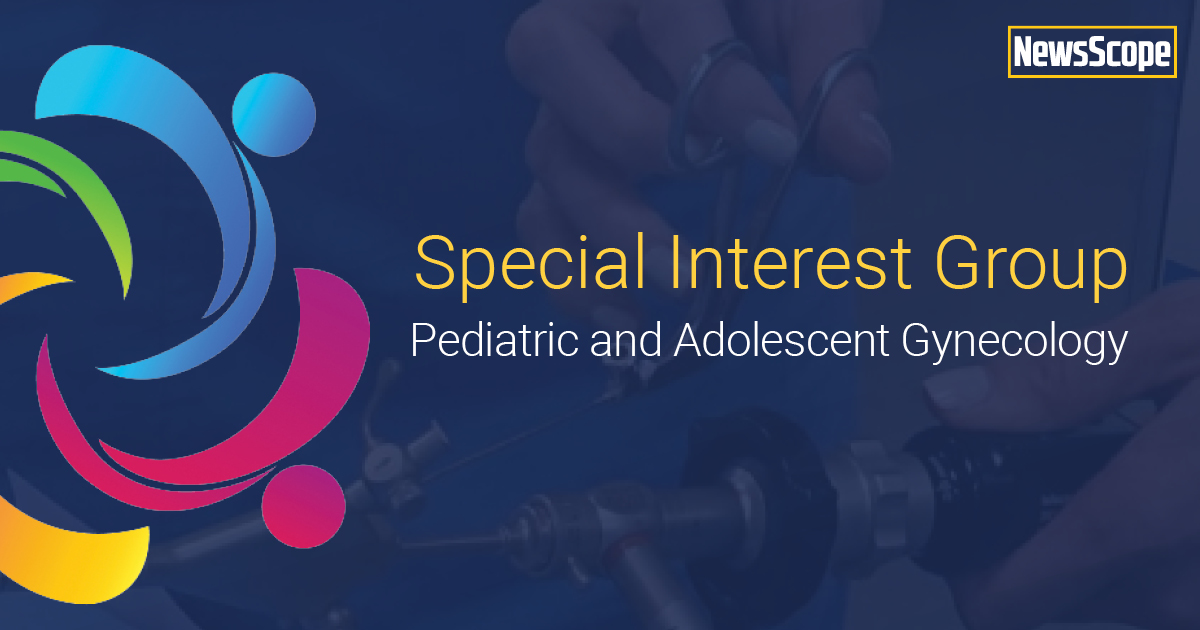Spotlight On: Pediatric and Adolescent Gynecology

This month we are spotlighting a new SurgeryU video and articles from the Pediatric Adolescent Gynecology Surgery Special Interest Group led by Nichole Tyson, MD, Chair and Kate McCracken, MD, Vice-Chair. SurgeryU features hundreds of high-definition surgical videos from surgeons from around the world. Access to SurgeryU is one of the many benefits included in your AAGL membership. If you would like access to these videos, CME programming, JMIG Journal, and member-only discounts on meetings, join AAGL today. These videos are being made available with public access for a limited time. Click here to join AAGL!
PAG SIG Video Recommendation – NEW to SurgeryU!
The Utility of Endosee® as a Vaginoscope in the Prepubertal Child by Madeleine Ross, MD and Ashli Lawson, MD
Pediatric surgical specialties often utilize instruments in novel ways to accommodate both patient anatomy and tolerance of in-office procedures. Specifically in pediatric and adolescent gynecology, a vaginal exam may be warranted, however speculums are not utilized. Prepubescent vaginal mucosa is unestrogenized, making it more prone to lacerations with minimal force. In addition, anxiety related to exams is much higher than in the mature adult population. Vaginoscopy thus has been adapted for evaluation of the vaginal cavity, mucosa, and cervix. Traditionally, vaginoscopy has been performed within the operating room under sedation. However, this proposal emphasizes the utility of the Endosee® as a tool to be used for vaginoscopy in the office setting.
The Endosee® was originally marketed as an in-office hysteroscope. It is a small device that consists of a single-use sterile 4.3mm semi-flexible cannula, which attaches to a handheld monitor for live viewing of the scope’s perspective. The Endosee® does not require a sophisticated fluid management system, rather tubing connected to the cannula may be infused with the distension media of choice using a 60cc syringe. Typically, less than 50cc of fluid is needed for vaginoscopy procedures. The Endosee® also offers an operative port, through which multiple reusable instruments such as biopsy forceps, foreign body graspers, or scissors may be inserted. This design and minimal set up make the Endosee® an ideal tool for evaluation of the vaginal cavity as a vaginoscope within pediatric gynecology.
In our practice, vaginoscopy has been utilized to assess cases of Mullerian anomaly, possible ectopic ureter or fistula, and retained foreign body. We premedicate the vestibule with lidocaine cream and introduce the patient to a Child Life Specialist for procedure preparation and distraction when needed. The procedure lasts less than 2 minutes and requires 1 assistant.
Recent evidence has touted the utility of vaginoscopy for evaluation of certain clinical situations, in which it may be superior to other diagnostic tests.1, 2, 3 Our practice has used this tool to assess for vaginal foreign bodies in the ER, potential vaginal fistulas, number of cervices, and vaginal lacerations in the setting of pelvic trauma.
In this new to SurgeryU video, “The Utility of Endosee as a Vaginoscope in the Prepubertal Child,” we present cases where the Endosee® has been modified to use as a vaginoscope that can be employed even in the office setting to avoid speculum exam or sedation.
References
- Pradhan S, Vilanova-Sanchez A, McCracken KA, et al. The Mullerian Black Box: Predicting and defining Mullerian anatomy in patients with cloacal abnormalities and the need for longitudinal assessment. J Pediatr Surg. 2018;53(11):2164-2169. doi:10.1016/j.jpedsurg.2018.05.009
- Giordano P, Drew PJ, Taylor D, Duthie G, Lee PW, Monson JR. Vaginography–investigation of choice for clinically suspected vaginal fistulas. Dis Colon Rectum. 1996;39(5):568-572. doi:10.1007/BF02058713
- Champagne BJ, McGee MF. Rectovaginal fistula. Surg Clin North Am. 2010;90(1):. doi:10.1016/j.suc.2009.09.003
About the Authors: Madeleine Ross, MD and Ashli Lawson, MD

Drs. Ross and Lawson are members of the AAGL Pediatric and Adolescent Gynecology Special Interest Group and physicians at the University of Missouri-Kansas City, Children’s Mercy Hospital in Kansas City, Missouri.
Unusual Case Presentation: Vaginal Bleeding in a Prepubertal Patient by Gylynthia E. Trotman, MD MPH FACOG
A 7-year-old, healthy female presented with new onset vaginal bleeding. Review of systems was otherwise unremarkable. Physical exam and initial labs confirmed no evidence of pubertal development. A pelvic ultrasound revealed small ovaries bilaterally and a prepubertal uterus measuring 4.1 x 2.1 x 2.7 cm with an endometrial polypoid mass, 1.6 x 1.2 x 1.7 cm with vascularity at its base. Magnetic resonance imaging (MRI) revealed a 1.6 cm bilobed hypervascular enhancing polypoid lesion in the endometrium with fluid distention of the endometrial cavity, concerning for sarcoma versus atypical endometrial polyp.
The patient was taken for vaginoscopy, hysteroscopy and endometrial biopsy. We anticipated challenges with her hypoestrogenic genital tract, limited working space and optimal equipment to biopsy and/or resection of the endometrial mass. A rigid, continuous flow, 9.5 Fr pediatric offset operative cystoscope with a 6 Fr working channel using 1.5% glycine solution as a distension media under positive pressure was chosen. The scope was advanced through the hymen and the labia majora pinched to allow fluid distention of the vagina. A global view of vagina and cervix revealed typical prepubertal appearance without lesions. The cystoscope was unable to be advanced beyond her internal cervical os. The scope was removed, and the cervix was visualized by applying retraction with the disarticulated upper and lower blades of a small Pederson speculum. The anterior lip of the cervix was grasped with an allis tenaculum and the cervix gently dilated to a 4mm Hegar dilator to allow the cystoscope to advance. Intrauterine placement of the cystoscope was confirmed with visualization of tubal ostia and the bilobed polypoid mass was noted. The cystoscope was removed and the 9 Fr cysto-resectoscope was introduced. The resectoscope provided a limited visual field, so was removed. The TruClear 
This case posed a particular challenge given the limitations for operative hysteroscopic access in a prepubertal patient. The need for assessment of the endometrial cavity is rare in this age group, therefore there is limited and variable clinical practice and published reports limited to postmenarhcal patients. (1) Although access to the endometrial cavity may be obtained with smaller diameter endoscopes, there are significant limitations for adequate sampling or resection of endometrial lesions.
References
- Jolinda Johary et.al. Use of hysteroscope for vaginoscopy or hysteroscopy in adolescents for the diagnosis and therapeutic management of gynecologic disorders: a systematic review. J Pediatr Adolesc Gynecol. 2015 Feb;28(1):29-37
Technology
Smaller genital structures and thin mucosa in prepubertal patients are subject to increased risk of iatrogenic trauma. (1) Considerations for operative hysteroscopy, including choice of instrument, cervical dilation/preparation and pressure, and fluid management, cannot simply be extrapolated from adult populations owning to anatomical and physiological differences as well as emotional maturity.
Advancements in the production of smaller diameter fiber optic endoscopes (1.2 to 5 mm) has allowed for an integrated system for magnification and are now routinely used for evaluation of the cervix and vagina via vaginoscopy. (2) Less is known about the use of these systems for hysteroscopic evaluation in the prepubertal patient.
The smaller outer diameter and shorter working lengths make operative pediatric cysto-urethroscopes particularly useful. The KARL STORZ system offers a 9.5 Fr 130 mm length endoscope which includes a 6 Fr working channel for limited instrumentation. The 9 Fr 120 mm pediatric resectoscope offers the ability to resect and apply electrocautery, however, is limited due to the smaller visual field it provides. (3)
Hysteroscopes may be used for access and a variety of flexible or rigid endoscopes are available for clinical use. However, many remain limited by relatively larger diameter requiring increased mechanical dilation and longer working lengths of 205 to 300 mm.
Flexible scopes such as the OLYMPUS 3.1mm HFY-XP and KARL STORZ 3.5 mm, are commonly in use. Disposable handheld devices Endosee ® Advance and LiNA OperaScope 
Smaller rigid hysteroscopes with an outer diameter of 4-5 mm with a 5 Fr working channel for semi rigid instruments such as offered by KARL STORZ offer improved optical viewing (6). It is limited by the requirement for 15 Fr resectoscope. (4) The Truclear 

Careful consideration for the adaptation of endoscopes for operative hysteroscopy in the pre-pubertal patient is paramount. Currently available hysteroscopes and pediatric cystoscopes are of value in this setting, however both with their own limitations.
References:
- Noam Smorgick et.al. Diagnosis and treatment of pediatric vaginal and genital tract abnormalities by small diameter hysteroscope. J Pediatr Surg. 2009 Aug;44(8):1506-8
- Jolinda Johary et.al. Use of hysteroscope for vaginoscopy or hysteroscopy in adolescents for the diagnosis and therapeutic management of gynecologic disorders: a systematic review. J Pediatr Adolesc Gynecol. 2015 Feb;28(1):29-37
- Gobbi et.al. Instrumentation for minimally invasive surgery in pediatric urology. Transl Pediatr 2016 Oct;5(4):186-204
- Bettocchi, Stefano & Di Spiezio Sardo, Attilio & Ceci, Oronzo. (2009). Instrumentation in Office Hysteroscopy: Rigid Hysteroscopy. p 1-6
About the Author: Gylynthia E. Trotman, MD MPH FACOG
Dr. Trotman is a member of the AAGL Pediatric and Adolescent Gynecology Special Interest Group, Chief of Pediatric and Adolescent Gynecology and Assistant Professor of Obstetrics and Gynecology and Pediatrics at Icahn School of Medicine at Mount Sinai Health System and Kravis Children’s Hospital in New York.
The post Spotlight On: Pediatric and Adolescent Gynecology appeared first on NewsScope.


